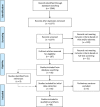Categorization and theoretical comparison of quantitative methods for assessing QT/RR hysteresis
- PMID: 28510313
- PMCID: PMC6931730
- DOI: 10.1111/anec.12463
Categorization and theoretical comparison of quantitative methods for assessing QT/RR hysteresis
Abstract
Background: In the human electrocardiogram, there is a lag of adaptation of the QT interval to heart rate changes, usually termed QT/RR hysteresis (QT-hys). Subject-specific quantifiers of QT-hys have been proposed as potential biomarkers, but there is no consensus on the choice of the quantifier.
Methods: A comprehensive literature search was conducted to identify original articles reporting quantifiers of repolarization hysteresis from the surface ECG in humans.
Results: Sixty articles fulfilled our inclusion criteria. Reported biomarkers were grouped under four categories. A simple mathematical model of QT/RR loop was used to illustrate differences between the methods. Category I quantifiers use direct measurement of QT time course of adaptation. They are limited to conditions where RR intervals are under strict control. Category IIa and IIb quantifiers compare QT responses during consecutive heart rate acceleration and deceleration. They are relevant when a QT/RR loop is observed, typically during exercise and recovery, but are not robust to protocol variations. Category III quantifiers evaluate the optimum RR memory in dynamic QT/RR relationship modeling. They estimate an intrinsic memory parameter independent from the nature of RR changes, but their reliability remains to be confirmed when multiple memory parameters are estimated. Promising approaches include the differentiation of short-term and long-term memory and adaptive estimation of memory parameters.
Conclusion: Model-based approaches to QT-hys assessment appear to be the most versatile, as they allow separate quantification of QT/RR dependency and QT-hys, and can be applied to a wide range of experimental settings.
Keywords: QT adaptation; QT hysteresis; quantitative ECG; repolarization.
© 2017 Wiley Periodicals, Inc.
Figures


Similar articles
-
Subject-specific profiles of QT/RR hysteresis.Am J Physiol Heart Circ Physiol. 2008 Dec;295(6):H2356-63. doi: 10.1152/ajpheart.00625.2008. Epub 2008 Oct 10. Am J Physiol Heart Circ Physiol. 2008. PMID: 18849333
-
Evaluation of a subject-specific transfer-function-based nonlinear QT interval rate-correction method.Physiol Meas. 2011 Jun;32(6):619-35. doi: 10.1088/0967-3334/32/6/001. Epub 2011 Apr 15. Physiol Meas. 2011. PMID: 21493981
-
A novel method for patient-specific QTc--modeling QT-RR hysteresis.Ann Noninvasive Electrocardiol. 2011 Jan;16(1):3-12. doi: 10.1111/j.1542-474X.2010.00401.x. Ann Noninvasive Electrocardiol. 2011. PMID: 21251128 Free PMC article.
-
The impact of varying autonomic states on the dynamic beat-to-beat QT-RR and QT-TQ interval relationships.Br J Pharmacol. 2008 Aug;154(7):1508-15. doi: 10.1038/bjp.2008.123. Epub 2008 Apr 21. Br J Pharmacol. 2008. PMID: 18663381 Free PMC article. Review.
-
Assessing QT prolongation and electrocardiography restitution using a beat-to-beat method.Cardiol J. 2010;17(3):230-43. Cardiol J. 2010. PMID: 20535712 Review.
Cited by
-
Sex and Rate Change Differences in QT/RR Hysteresis in Healthy Subjects.Front Physiol. 2022 Feb 7;12:814542. doi: 10.3389/fphys.2021.814542. eCollection 2021. Front Physiol. 2022. PMID: 35197861 Free PMC article.
-
Influence of heart rate correction formulas on QTc interval stability.Sci Rep. 2021 Jul 12;11(1):14269. doi: 10.1038/s41598-021-93774-9. Sci Rep. 2021. PMID: 34253795 Free PMC article.
-
Clinical applications of QT/RR hysteresis assessment: A systematic review.Ann Noninvasive Electrocardiol. 2018 Jan;23(1):e12514. doi: 10.1111/anec.12514. Epub 2017 Oct 30. Ann Noninvasive Electrocardiol. 2018. PMID: 29083088 Free PMC article.
-
Brazilian Guideline for Exercise Test in the Adult Population - 2024.Arq Bras Cardiol. 2024 Feb;121(3):e20240110. doi: 10.36660/abc.20240110. Arq Bras Cardiol. 2024. PMID: 38896581 Free PMC article. English, Portuguese. No abstract available.
-
Importance of QT/RR hysteresis correction in studies of drug-induced QTc interval changes.J Pharmacokinet Pharmacodyn. 2018 Jun;45(3):491-503. doi: 10.1007/s10928-018-9587-8. Epub 2018 Apr 12. J Pharmacokinet Pharmacodyn. 2018. PMID: 29651591 Free PMC article.
References
-
- Arnold, L. , Page, J. , Attwell, D. , Cannell, M. , & Eisner, D. A. (1982). The dependence on heart‐rate of the human ventricular action‐potential duration. Cardiovascular Research, 16, 547–551. - PubMed
-
- Baumert, M. , Lambert, G. W. , Dawood, T. , Lambert, E. A. , Esler, M. D. , McGrane, M. , … Nalivaiko, E. (2008). QT interval variability and cardiac norepinephrine spillover in patients with depression and panic disorder. American Journal of Physiology‐Heart and Circulatory Physiology, 295, H962–H968. - PubMed
-
- Baumert, M. , Seeck, A. , Faber, R. , Nalivaiko, E. , & Voss, A. (2010). Longitudinal changes in QT interval variability and rate adaptation in pregnancies with normal and abnormal uterine perfusion. Hypertension Research, 33, 555–560. - PubMed
-
- Bazett, H. C. (1920). An analysis of the time relations of electrocardiograms. Heart, 7, 353–370.
Publication types
MeSH terms
LinkOut - more resources
Full Text Sources
Other Literature Sources

